Bipedalism is the locomotion of some animals that use two legs or limbs to move around. When they walk and run, their feet alternately step as they half-cycle out with each other. The feet move simultaneously or almost.
The animals that walk on two legs are emus, jerboas, kangaroo rats, green basilisk lizards, ostriches, gibbons, flamingos, penguins, chimpanzees, bears, wallabies, giant pangolins, gorillas, kangaroos, and humans.
As you can see, humans are included in the list of animals that walk on two legs. But they do it differently from other animals. To know more about the different animals that walk on two legs, read on.
Table of Contents
15 Animals That Walk on Two Legs
Emus

The emus can keep up with the speed of 13.4 m/s and a 3-meter stride. It just shows the strength of its legs that are strong enough to kick a predator or destroy a fence.
- Scientific Name: Dromaius novaehollandiae
- Appearance: Emus have three toes that face forward like a running bird. It has bare legs with calf muscles utilized for long-distance running and sprinting. The long neck of an emu is whitish blue. Both its beak and feathers are black. It has small wings that flap, but unfortunately, they don’t make a difference in this bird’s mobility.
- Color: Camouflage, tan, whitish-blue, black
- Lifespan: 5 to 16 years or up to 20 years
- Habitat: Available biomes, grassland, Savannah forest
- Height: Up to 190 cm
- Weight: 36 to 40 kg
- Diet: Mammals, insects, amphibians, reptiles, stems, bark, wood, nuts, grains, fruits, dung
- Place of Origin: Australia
- Characteristics: Nomadic; diurnal; migratory; motile
Jerboas

Jerboas can thrive in cold and hot deserts. They can run gaits, skip, and hop. Moreover, they can run at a maximum speed of 24 km per hour.
- Scientific Name: Dipodidae
- Appearance: Jerboas can jump up to 10 feet away due to their hind legs that are 10 times longer than the fore ones. They get the leverage for jumping from the bones of their feet that form like long cannons. Since they dwell in sandy places, they have fur on their feet’s undersides for traction. They have long tails too.
- Color: Sand-colored
- Lifespan: Up to 6 years
- Habitat: Sandy areas
- Height: 2 to 5.9 inches
- Weight: Around 28 grams
- Diet: Plant material, hard seeds, beetles, and other insects
- Place of Origin: North America, North Africa, Asia, Eurasia
- Characteristics: Crepuscular; burrowing; hibernate; swift diggers
Kangaroo Rats
A kangaroo rat can move bipedally and with a top speed of 10 km per hour. It can leap from 7 to 9 feet and quickly go in different directions. It’s one of its ways to avoid predators together with its ‘move-freeze’ ability.
- Scientific Name: Dipodomys
- Appearance: Also classified as a heteromyid rodent, a kangaroo rat has four or five toes. Its forelegs are smaller than its hind legs, while its head is relatively big. The tail is double the length of its body.
- Color: Cinnamon, dark gray
- Lifespan: Up to 9 years
- Habitat: Sandy, soft soil
- Height: 1.8 to 2.4 inches
- Weight: 70 to 170 grams
- Diet: Seeds, vegetation
- Place of Origin: Western part of North America
- Characteristics: Burrowing; social in a small group; solitary
Green Basilisk Lizards

As a semi-aquatic creature, it can be sacred when on land. When this happens, it runs using its hind legs. It can sprint so fast up to 11.3 km per hour. Furthermore, it can run over the waters with the help of special scales under its feet. This action can be demonstrated at a fair distance before the surface tension breaks.
- Scientific Name: Basiliscus plumifrons
- Appearance: The ears on its triangular head are larger than the eyes. It has granular scales all over its body. The hind limbs are longer than the front ones. It has long, flattened toes and a strongly compressed tail.
- Color: Bright green, gray, light blue, white, black
- Lifespan: 5 to 6 years
- Habitat: Near bodies of water
- Height: Unknown
- Weight: 198 grams
- Diet: Smaller lizards, small mammals, crawfish, snails, spiders, insects
- Place of Origin: Rainforests of Costa Rica, Panama, Honduras, and Nicaragua
- Characteristics: Semi-arboreal; semi-aquatic
Ostriches
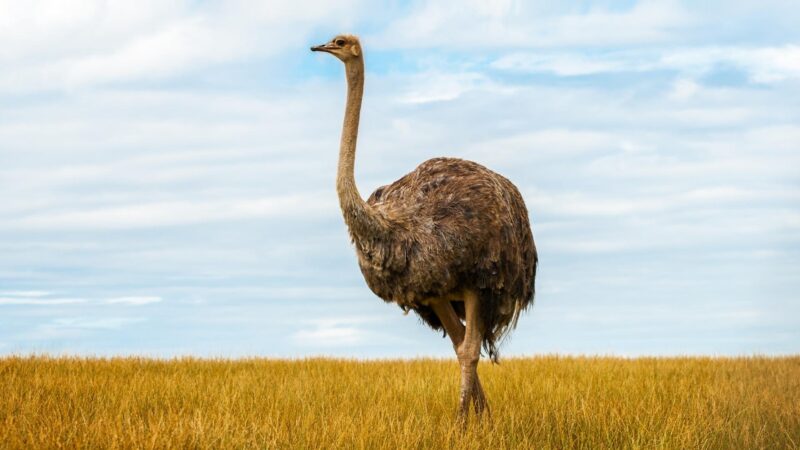
A flock of ostriches can have 5 to 50 birds. Although they can’t fly, they run at 30 to 37 miles per hour and sprint up to 43 miles per hour. A single stride of an ostrich can stride more than 10 feet. This is the amazing capability of its long, strong legs.
- Scientific Name: Struthio camelus
- Appearance: Based on common knowledge, this is the largest living bird. Males have black and white feathers, while females have gray-brown.
- Color: Black, white, gray-brown
- Lifespan: Up to 50 years
- Habitat: Scrub forest, grassland, or savanna
- Height: 5.6 to 9 feet
- Weight: 90 to 130 kg
- Diet: Insects, carrion, seed, nuts, grains, fruits, leaves
- Place of Origin: Ethiopian region
- Characteristics: Diurnal; motile; nomadic; social; dominance hierarchies; territorial
Gibbons
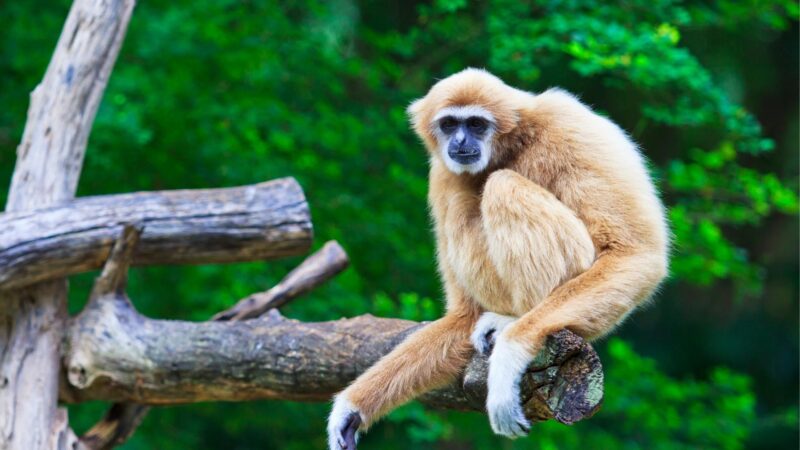
They may swing from branches to branches most of the time, but they execute the bipedal movement too. Gibbons’ arms are so long that they can’t walk on all fours. Instead, they can put their hands on their heads for balance.
- Scientific Name: Hylobatidae
- Appearance: The arms of gibbons are considerably long. There’s thick skin on their buttocks to let them sit comfortably on a tree.
- Color: Brownish, white, black
- Lifespan: 30 to 35 years
- Habitat: Rainforests
- Height: 1.3 to 2.9 feet
- Weight: 4.4 to 11.9 kg
- Diet: Fruits, flowers, twigs, leaves, insects, bird’s egg
- Place of Origin: Southern Asia
- Characteristics: Social; territorial; vocal and visual display
Flamingos
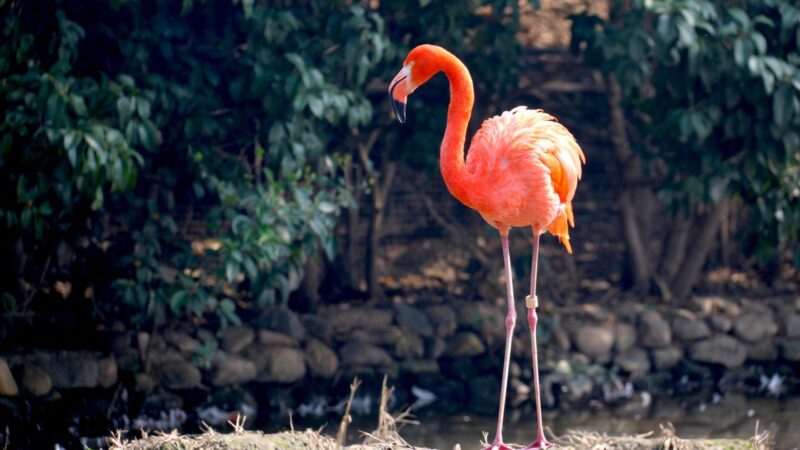
With the three web toes, flamingos can walk and even run with ease. The back toe may be tiny or missing at all, so they can do it even with thin legs and relatively small feet. They can even stand on one leg while the other leg is fully submerged in the water below their bodies.
- Scientific Name: Phoenicopteridae
- Appearance: Flamingos are attractive birds due to their bright pink and red colors. They have long, thin legs and long necks that can curve in various directions.
- Color: Bright pink, red, white
- Lifespan: 30 to 40 years or up to 50 years
- Habitat: Large lakes, wetlands, bodies of saltwater, and freshwater
- Height: 2.6 to 4.9 feet
- Weight: 1.2 to 4 kg
- Diet: Non-insect arthropods, insects, vertebrates, mollusks, crustaceans, nematodes, worms, small fish
- Place of Origin: Palearctic, Ethiopian, Oriental, and Neotropical regions
- Characteristics: Social; colonial; sedentary; motile; nocturnal; diurnal
Penguins
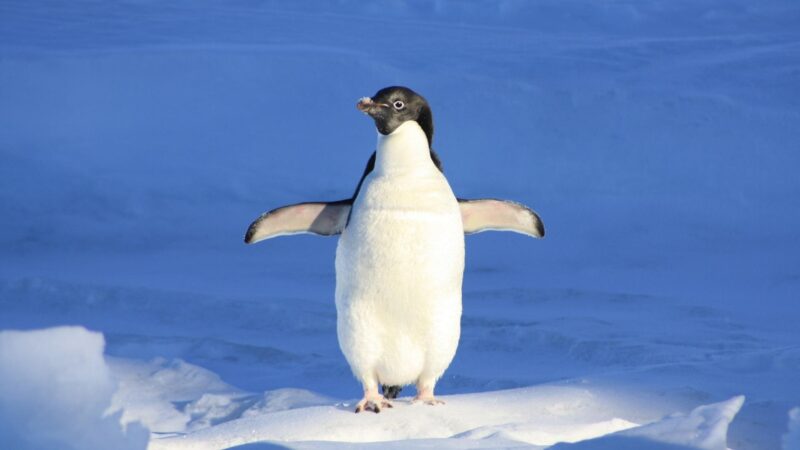
Penguins are adorable creatures known for their upright posture and waddling. Surprisingly, they have knee, femur, fibula, and tibia, which can also be found in human anatomy.
These are the reasons why they can waddle despite their fusiform structure. In addition, their legs may look shorter as they’re concealed by feathers.
- Scientific Name: Sphenisciformes
- Appearance: Penguins are birds with blue-black plumage. They have stiff wings that don’t fold.
- Color: Blue-black, gray, white
- Lifespan: 6 to 20 years
- Habitat: Coasts, oceans
- Height: .90 to 4.2 feet
- Weight: 1 to 40 kg
- Diet: Cuttlefish, squid, anchovies, krill, and pilchards
- Place of Origin: Antarctic, Sub-Antarctic
- Characteristics: Social; vocal and visual display
Chimpanzees
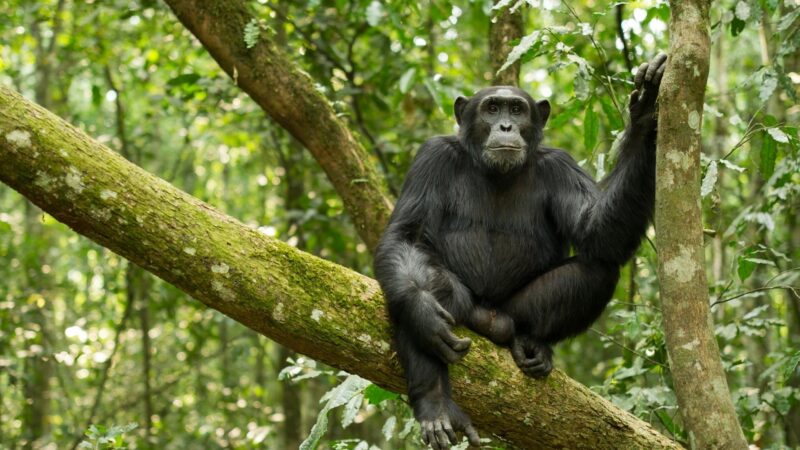
Aside from walking on all fours, chimpanzees can do it bipedally. Whenever they walk on two feet, they have an orthograde posture and practice the hind limb mechanism.
- Scientific Name: Pan troglodytes
- Appearance: Chimpanzees have black or brown fur. They have prominent crests and ears, and these features give them a bony, rigid look.
- Color: Black, brown
- Lifespan: 40 to 60 years
- Habitat: Forest savanna, rainforests, mountain forests
- Height: 3.2 to 5.5 feet
- Weight: 26 to 70 kg
- Diet: Plants, sap or plant fluids, fruits, mammals, birds, eggs, reptiles, insects
- Place of Origin: Ethiopian region
- Characteristics: Social; diurnal; long memories; physical cues and body language
Bears
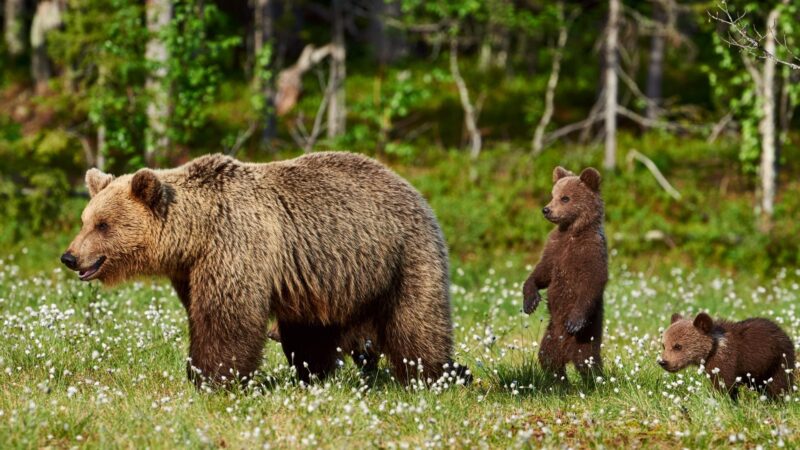
While bears can walk on all fours, they can also walk with their heels touching the ground as humans do. They can walk at 3.4 miles per hour. Nonetheless, they can run when chased or after prey at 25 miles per hour.
- Scientific Name: Ursidae
- Appearance: Bears are huge animals that are robustly built. So, the skull is also enormous. They have claws for ripping and digging and feet with hairy soles.
- Color: Brown, black, white
- Lifespan: Up to 25 years
- Habitat: Mountains, tropical and temperate forests, deserts, grasslands, Arctic tundra
- Height: 1.9 to 8.2 feet
- Weight: 25 to 65 kg or up to 800 kg
- Diet: Omnivore
- Place of Origin: All continents except Australia and Antarctica
- Characteristics: Acoustic, visual; chemical; tactile
Wallabies
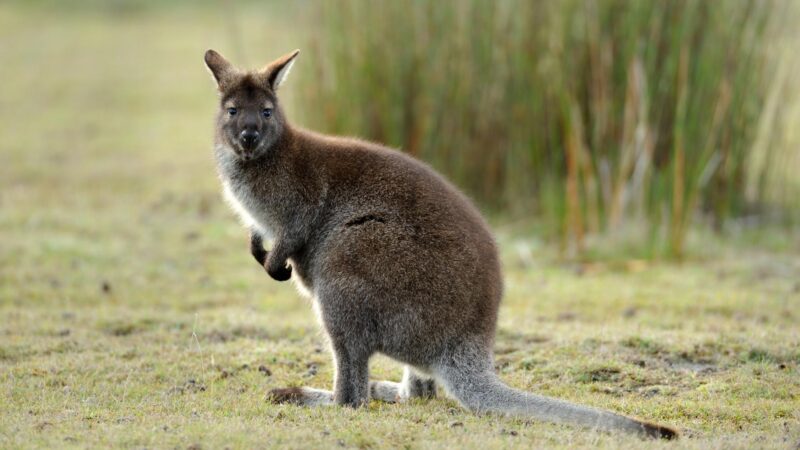
Wallabies are marsupials or pouched animals. Due to their strong hind legs, they can jump speedily at a great distance. They use their tails for balance.
- Scientific Name: Notamacropus
- Appearance: The species of wallabies are small to medium-sized. They have large ears and pointed snouts.
- Color: Black, white, gray, brown
- Lifespan: 12 to 15 years
- Habitat: Rugged or heavily timbered areas, semi-arid plains
- Height: 1 to 3.4 feet or up to 6 feet
- Weight: 1.81 to 24 kg
- Diet: Grasses, leaves, vegetables
- Place of Origin: Australia, New Guinea
- Characteristics: Grazers; browsers
Giant Pangolins
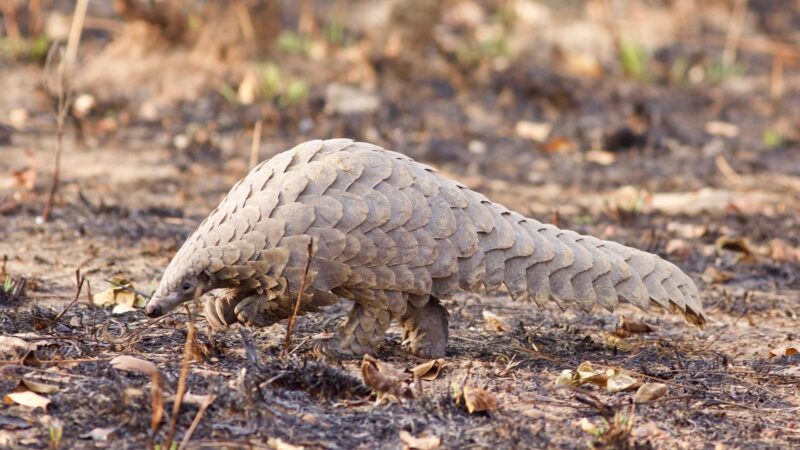
This is the largest and heaviest pangolin species. It has wrinkled skin on the feet’s ventral side, as well as a granular pad so it can walk. There are a few scales on its tail and legs, so it can move with ease.
- Scientific Name: Manis gigantea
- Appearance: A giant pangolin has an elongated body and thick tail. When its tongue is retracted, it can be 70 cm long. Its body is covered with scales that are 4 to 5 inches long, and it has only a few hairs. These scales don’t get easily worn out by soil and rock when this animal digs.
- Color: Grey-brown
- Lifespan: Up to 4 years
- Habitat: Savannas, forests
- Height: 1 to 3 feet
- Weight: 30 to 35 kg
- Diet: Ants, termites
- Place of Origin: Ethiopian region
- Characteristics: Fossorial; motile; solitary; sedentary; nocturnal
Gorillas

You’ll commonly see gorillas knuckle-walking, but they can also walk on two feet. They do it when gathering food within short distances and for defense reasons.
- Scientific Name: Gorilla
- Appearance: Gorillas have a dark color and long arms that can be up to 2.6 meters long.
- Color: Dark
- Lifespan: 30 to 40 years or up to 65 years
- Habitat: Tropical and subtropical forests
- Height: 3.2 to 5.9 feet
- Weight: 100 to 270 kg
- Diet: Leaves, stems, piths, shoots, fruits
- Place of Origin: Equatorial Africa
- Characteristics: Gentle; displays emotion
Kangaroos

Marsupials like kangaroos are unique because of their pouches where their young develop. It’s also the same thing with its hind legs that grow for long-distance travel. These legs are supported by tendons that can bear elastic strain energy. The hopping of kangaroos is related to how they breathe.
- Scientific Name: Macropus
- Appearance: Kangaroos have huge hind legs and powerful tails. The toes are distinctively arranged as the fourth one, the largest and strongest. The fifth toe is just moderate and likely missing, while the second and third are linked. Their ears are too large for their relatively small heads.
- Color: Grey, brown, tan
- Lifespan: 8 to 23 years
- Habitat: Grasslands, shrub lands, deserts
- Height: 4 to 7 feet
- Weight: 40 to 90 kg or more
- Diet: Plants
- Place of Origin: Australia, New Guinea
- Characteristics: Nocturnal; diurnal
Humans

The trunk of humans is erect when walking. Also, the knees are straight and in mid-stance. Even though humans lack hair, they can walk and run a long distance in hot weather. These abilities may have developed from hunting and scavenging that early humans did.
- Scientific Name: Homo sapiens
- Lifespan: 32 to 84 years or up to 122 years
Summary
If you notice, birds and marsupials are on the list of animals that walk on two legs. Some of them have a pair of legs, including humans. Apes like chimpanzees, gibbons, and gorillas can either walk on all four or bipedal. The hind, strong legs made it possible for some animals to have the ability to do bipedal movements.
List of Sources
Shorter, G. (2012). Dromaius novaehollandiae. Animal Diversity Web.
How Fast is an Ostrich? And More Fun Facts. (2022). Smithsonian’s National Zoo & Conservation Biology Institute.
Howard, L. (2003). Sphenisciformes. Animal Diversity Web.
Dewey, T. (2008). Homo sapiens. Animal Diversity Web.
Moeller, K. (2020). Keeping up With Kangaroos. Arizona State University – Ask A Biologist.
